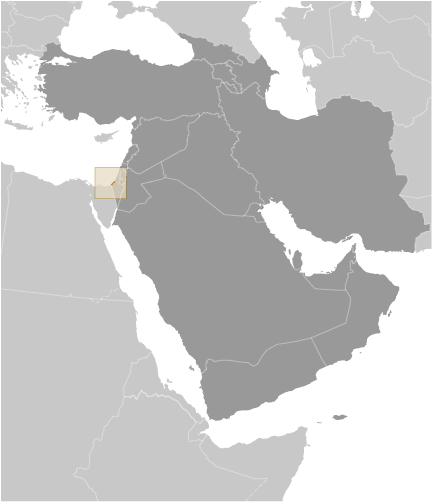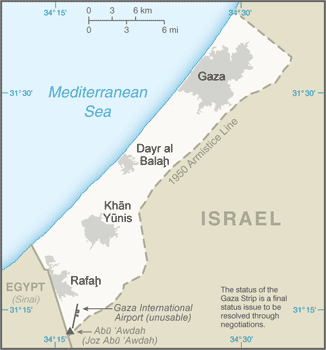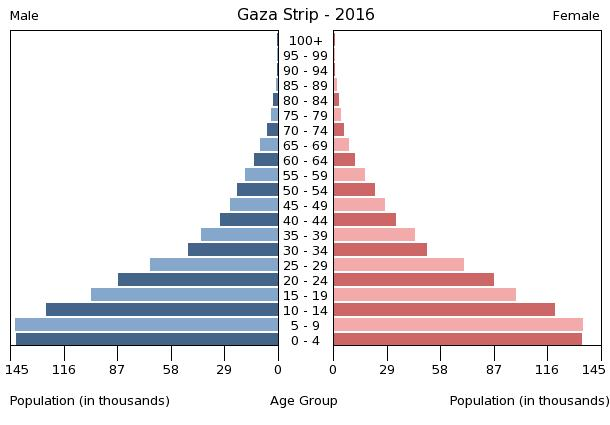Introduction :: GAZA STRIP
-
Inhabited since at least the 15th century B.C., Gaza has been dominated by many different peoples and empires throughout its history; it was incorporated into the Ottoman Empire in the early 16th century. Gaza fell to British forces during World War I, becoming a part of the British Mandate of Palestine. Following the 1948 Arab-Israeli War, Egypt administered the newly formed Gaza Strip; it was captured by Israel in the Six-Day War in 1967. Under a series of agreements known as the Oslo accords signed between 1994 and 1999, Israel transferred to the newly-created Palestinian Authority (PA) security and civilian responsibility for many Palestinian-populated areas of the Gaza Strip as well as the West Bank. Negotiations to determine the permanent status of the West Bank and Gaza Strip stalled in 2001, after which the area witnessed a violent intifada or uprising.
In early 2003, the "Quartet" of the US, EU, UN, and Russia presented a roadmap to a final peace settlement by 2005, calling for two states. Following PA President Yasir ARAFAT's death in late 2004 and the subsequent election of Mahmud ABBAS (head of the Fatah political faction) as the PA president in 2005, Israel and the Palestinians agreed to move the peace process forward. Israel by late 2005 unilaterally withdrew all of its settlers and soldiers and dismantled its military facilities in the Gaza Strip, but continues to control the Gaza Strip’s land and maritime borders and airspace. In early 2006, the Islamic Resistance Movement (HAMAS) won a majority in the Palestinian Legislative Council election. Attempts to form a unity government between Fatah and HAMAS failed and violent clashes between their respective supporters ensued, culminating in HAMAS's violent seizure of all military and governmental institutions in the Gaza Strip in June 2007. Since HAMAS’s takeover, Israel and Egypt have enforced tight restrictions on movement and access of goods and individuals into and out of the territory. Fatah and HAMAS have since reached a series of agreements aimed at restoring political unity between the Gaza Strip and the West Bank but have struggled to implement them. In April 2014, the two factions signed an agreement and two months later President ABBAS formed an interim government of independent technocrats, none of whom were affiliated with HAMAS. The factions, however, continue to disagree over how to implement the deal and HAMAS remains in de facto control of the Gaza Strip.
In July 2014, HAMAS and other Gaza-based militant groups engaged in a 51-day conflict with Israel — the third conflict since HAMAS’s takeover in 2007 — culminating in late August with an open-ended truce that continues to hold despite the absence of a negotiated cease-fire and occasional violations by both sides. Reconstruction efforts since the end of the conflict have been hampered by Israeli restrictions on goods entering the Gaza Strip and inadequate donor aid. The UN in 2015 published a study assessing that the Gaza Strip could become uninhabitable by 2020 absent a substantial easing on border restrictions. In an attempt to reenergize peace talks between the Israelis and Palestinians, France in June 2016 hosted a ministerial meeting that included participants from 29 countries, although not Israel or the Palestinians, to lay the groundwork for an envisioned "multilateral peace conference" later in the year.
Geography :: GAZA STRIP
-
Middle East, bordering the Mediterranean Sea, between Egypt and Israel
31 25 N, 34 20 E
Middle East
total: 360 sq km
land: 360 sq km
water: 0 sq km
country comparison to the world: 206
slightly more than twice the size of Washington, DC
total: 72 km
border countries (2): Egypt 13 km, Israel 59 km
40 km
see entry for Israel
note: effective 3 January 2009, the Gaza maritime area is closed to all maritime traffic and is under blockade imposed by Israeli Navy until further notice
temperate, mild winters, dry and warm to hot summers
flat to rolling, sand- and dune-covered coastal plain
mean elevation: NA
elevation extremes: lowest point: Mediterranean Sea 0 m
highest point: Abu 'Awdah (Joz Abu 'Awdah) 105 m
arable land, natural gas
240 sq km; note - includes West Bank (2012)
population concentrated in major cities, particularly Gaza City in the north
droughts
desertification; salination of fresh water; sewage treatment; water-borne disease; soil degradation; depletion and contamination of underground water resources
strategic strip of land along Mideast-North African trade routes has experienced an incredibly turbulent history; the town of Gaza itself has been besieged countless times in its history; there are no Israeli settlements in the Gaza Strip; the Gaza Strip settlements were evacuated in 2005 (2014)
People and Society :: GAZA STRIP
-
1,753,327 (July 2016 est.)
country comparison to the world: 153
noun: NA
adjective: NA
Palestinian Arab
Arabic, Hebrew (spoken by many Palestinians), English (widely understood)
Muslim 98.0 - 99.0% (predominantly Sunni), Christian <1.0%, other, unaffiliated, unspecified <1.0%
note: dismantlement of Israeli settlements was completed in September 2005; Gaza has had no Jewish population since then (2012 est.)
religious affiliation:

Middle East
::GAZA STRIP

0-14 years: 45.4% (male 408,601/female 387,463)
15-24 years: 21.21% (male 187,229/female 184,619)
25-54 years: 27.56% (male 237,162/female 246,021)
55-64 years: 3.32% (male 30,575/female 27,717)
65 years and over: 2.51% (male 22,613/female 21,327) (2016 est.)
population pyramid:

Middle East
::GAZA STRIP

Population Pyramid
A population pyramid illustrates the age and sex structure of a country's population and may provide insights about political and social stability, as well as economic development. The population is distributed along the horizontal axis, with males shown on the left and females on the right. The male and female populations are broken down into 5-year age groups represented as horizontal bars along the vertical axis, with the youngest age groups at the bottom and the oldest at the top. The shape of the population pyramid gradually evolves over time based on fertility, mortality, and international migration trends.
For additional information, please see the entry for Population pyramid on the Definitions and Notes page under the References tab.
total dependency ratio: 76%
youth dependency ratio: 70.8%
elderly dependency ratio: 5.2%
potential support ratio: 19.2%
note: data represent Gaza Strip and the West Bank (2015 est.)
total: 16.9 years
male: 16.6 years
female: 17.2 years (2016 est.)
country comparison to the world: 224
2.39% (2016 est.)
country comparison to the world: 30
32.3 births/1,000 population (2016 est.)
country comparison to the world: 33
3.2 deaths/1,000 population (2016 est.)
country comparison to the world: 221
-5.2 migrant(s)/1,000 population (2016 est.)
country comparison to the world: 195
population concentrated in major cities, particularly Gaza City in the north
urban population: 75.3% of total population (2015)
rate of urbanization: 2.81% annual rate of change (2010-15 est.)
note: data represent Gaza Strip and West Bank
at birth: 1.06 male(s)/female
0-14 years: 1.05 male(s)/female
15-24 years: 1.01 male(s)/female
25-54 years: 0.96 male(s)/female
55-64 years: 1.1 male(s)/female
65 years and over: 0.71 male(s)/female
total population: 1.02 male(s)/female (2016 est.)
19
note: median age at first birth among women 25-29 (2004 est.)
45 deaths/100,000 live births
note: data represent Gaza Strip and West Bank (2015 est.)
country comparison to the world: 94
total: 17.1 deaths/1,000 live births
male: 18.2 deaths/1,000 live births
female: 15.9 deaths/1,000 live births (2016 est.)
country comparison to the world: 98
total population: 73.9 years
male: 72.3 years
female: 75.7 years (2016 est.)
country comparison to the world: 125
4.3 children born/woman (2016 est.)
country comparison to the world: 32
52.5% (includes Gaza Strip and West Bank) (2010)
2.1 physicians/1,000 population (2013)
1.3 beds/1,000 population (2010)
improved:
urban: 50.7% of population
rural: 81.5% of population
total: 58.4% of population
unimproved:
urban: 49.3% of population
rural: 18.5% of population
total: 41.6% of population
note: includes Gaza Strip and the West Bank (2015 est.)
improved:
urban: 93% of population
rural: 90.2% of population
total: 92.3% of population
unimproved:
urban: 7% of population
rural: 9.8% of population
total: 7.7% of population
note: includes Gaza Strip and the West Bank (2015 est.)
NA
NA
NA
definition: age 15 and over can read and write
total population: 96.5%
male: 98.4%
female: 94.5%
note: estimates are for Gaza and the West Bank (2015 est.)
total: 13 years
male: 12 years
female: 14 years
note: data represent Gaza and West Bank (2014)
total: 41%
male: 37%
female: 64.7%
note: includes the West Bank (2013 est.)
country comparison to the world: 14
Government :: GAZA STRIP
-
conventional long form: none
conventional short form: Gaza Strip
local long form: none
local short form: Qita' Ghazzah
etymology: named for the largest city in the region, Gaza, whose settlement can be traced back to at least the 15th century B.C. (as "Ghazzat")
Economy :: GAZA STRIP
-
Israeli security measures and Israeli-Palestinian violence continue to degrade economic conditions in the Gaza Strip, the smaller of the two areas comprising the Palestinian territories. Israeli-imposed border controls became more restrictive after HAMAS seized control of the territory in June 2007. They have produced high unemployment, elevated poverty rates, and a sharp contraction of the private sector, which had relied primarily on export markets.
Egypt’s ongoing crackdown on the Gaza Strip’s extensive tunnel-based smuggling network has exacerbated fuel, construction material, and consumer goods shortages in the territory. The 51-day conflict in July 2014 that HAMAS and other Gaza-based militant groups fought with Israel further depressed the Gaza Strip’s already aid-dependent economy. Donor support for reconstruction and relaxed Israeli import restrictions in 2014 and 2015 have fallen short of postconflict needs, with almost 100,000 people remaining internally displaced because their homes have yet to be rebuilt or repaired.
see entry for the West Bank
$2.938 billion (2014 est.)
note: excludes the West Bank
-15.2% (2014 est.)
5.6% (2013 est.)
7% (2012)
note: excludes the West Bank
country comparison to the world: 222
see entry for the the West Bank
household consumption: 93%
government consumption: 26.6%
investment in fixed capital: 23.8%
investment in inventories: -2.6%
exports of goods and services: 18.3%
imports of goods and services: -59.2%
note: data exclude the West Bank (2015 est.)
4.7%
13.7%
81.6%
note: data exclude the West Bank (2014 est.)
olives, fruit, vegetables, flowers; beef, dairy products
textiles, food processing, furniture
3.4% see entry for the West Bank
country comparison to the world: 63
1.106 million
note: excludes the West Bank (2015 est.)
country comparison to the world: 143
agriculture: 5.2%
industry: 10%
services: 84.8%
note: data exclude the West Bank (2015 est.)
25.9% (2014 est.)
26.2% (2013 est.)
note: data exclude the West Bank
country comparison to the world: 181
30%
note: data exclude the West Bank (2011 est.)
see entry for the West Bank
calendar year
1.4% (2015 est.)
1.7% (2014 est.)
note: 2.9% excludes the West Bank
country comparison to the world: 100
see entry for the West Bank
see entry for the West Bank
$2.356 billion (31 December 2014 est.)
$2.16 billion (31 December 2013 est.)
country comparison to the world: 149
$1.418 billion (31 December 2015 est.)
$1.147 billion (31 December 2014 est.)
country comparison to the world: 152
-$2.894 billion (2014 est.)
-$1.412 billion (2013 est.)
note: excludes the West Bank
country comparison to the world: 158
$1.343 billion (2013 est.)
country comparison to the world: 149
strawberries, carnations, vegetables, fish (small and irregular shipments, as permitted to transit the Israeli-controlled Kerem Shalom crossing)
see entry for the West Bank
food, consumer goods, fuel
see entry for the West Bank
see entry for the West Bank
Energy :: GAZA STRIP
-
population without electricity: 80,930
electrification - total population: 98%
electrification - urban areas: 99%
electrification - rural areas: 93%
note: data for Gaza Strip and West Bank combined (2012)
51,000 kWh (2011 est.)
country comparison to the world: 220
202,000 kWh (2009)
country comparison to the world: 217
0 kWh (2011 est.)
country comparison to the world: 149
193,000 kWh (2011 est.)
country comparison to the world: 111
0 bbl (1 January 2010 es)
country comparison to the world: 144
Communications :: GAZA STRIP
-
406,500 (includes the West Bank) (July 2015 est.)
total: 3,531,000 (includes the West Bank)
subscriptions per 100 inhabitants: 76 (includes the West Bank) (July 2015 est.)
general assessment: Gaza continues to repair the damage to its telecommunications infrastructure caused by fighting in 2009
domestic: Israeli company BEZEK and the Palestinian company PALTEL are responsible for fixed-line services; the Palestinian JAWWAL company provides cellular services
international: country code - 970 (2009)
1 TV station and about 10 radio stations; satellite TV accessible (2008)
.ps; note - same as the West Bank
total: 2.673 million (includes the West Bank)
percent of population: 57.4% (includes the West Bank) (July 2015 est.)
Transportation :: GAZA STRIP
-
1 (2013)
country comparison to the world: 219
total: 1
over 3,047 m: 1 (2013)
1 (2013)
note: see entry for the West Bank
major seaport(s): Gaza
Military and Security :: GAZA STRIP
-
HAMAS does not have a conventional military in the Gaza Strip but maintains security forces in addition to its military wing, the 'Izz al-Din al-Qassam Brigades; the military wing reports to the Hamas Political Bureau leadership, which remains scattered throughout the region since relocating from its Damascus headquarters in early 2012 (2015)
Transnational Issues :: GAZA STRIP
-
the status of the Gaza Strip is a final status issue to be resolved through negotiations; Israel removed settlers and military personnel from Gaza Strip in September 2005
refugees (country of origin): 1,276,929 (Palestinian refugees) (2015)
IDPs: 221,000 (includes persons displaced within the Gaza strip due to the intensification of the Israeli-Palestinian conflict since June 2014 and other Palestinian IDPs in the Gaza Strip and West Bank who fled as long ago as 1967, although confirmed cumulative data do not go back beyond 2006) (2015)














